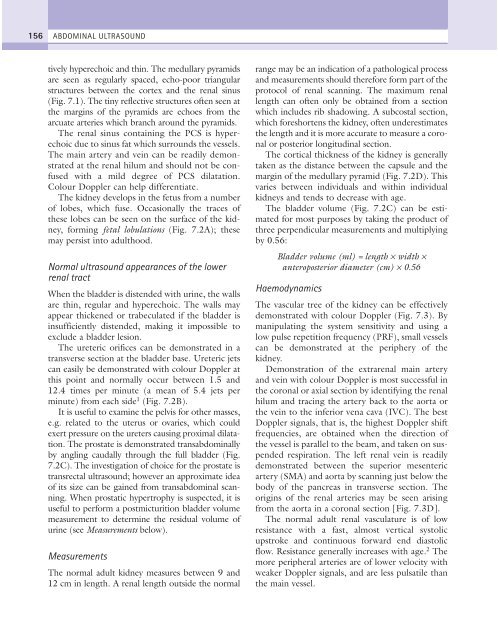9%20ECOGRAFIA%20ABDOMINAL%20COMO%20CUANDO%20DONDE
You also want an ePaper? Increase the reach of your titles
YUMPU automatically turns print PDFs into web optimized ePapers that Google loves.
156<br />
ABDOMINAL ULTRASOUND<br />
tively hyperechoic and thin. The medullary pyramids<br />
are seen as regularly spaced, echo-poor triangular<br />
structures between the cortex and the renal sinus<br />
(Fig. 7.1). The tiny reflective structures often seen at<br />
the margins of the pyramids are echoes from the<br />
arcuate arteries which branch around the pyramids.<br />
The renal sinus containing the PCS is hyperechoic<br />
due to sinus fat which surrounds the vessels.<br />
The main artery and vein can be readily demonstrated<br />
at the renal hilum and should not be confused<br />
with a mild degree of PCS dilatation.<br />
Colour Doppler can help differentiate.<br />
The kidney develops in the fetus from a number<br />
of lobes, which fuse. Occasionally the traces of<br />
these lobes can be seen on the surface of the kidney,<br />
forming fetal lobulations (Fig. 7.2A); these<br />
may persist into adulthood.<br />
Normal ultrasound appearances of the lower<br />
renal tract<br />
When the bladder is distended with urine, the walls<br />
are thin, regular and hyperechoic. The walls may<br />
appear thickened or trabeculated if the bladder is<br />
insufficiently distended, making it impossible to<br />
exclude a bladder lesion.<br />
The ureteric orifices can be demonstrated in a<br />
transverse section at the bladder base. Ureteric jets<br />
can easily be demonstrated with colour Doppler at<br />
this point and normally occur between 1.5 and<br />
12.4 times per minute (a mean of 5.4 jets per<br />
minute) from each side 1 (Fig. 7.2B).<br />
It is useful to examine the pelvis for other masses,<br />
e.g. related to the uterus or ovaries, which could<br />
exert pressure on the ureters causing proximal dilatation.<br />
The prostate is demonstrated transabdominally<br />
by angling caudally through the full bladder (Fig.<br />
7.2C). The investigation of choice for the prostate is<br />
transrectal ultrasound; however an approximate idea<br />
of its size can be gained from transabdominal scanning.<br />
When prostatic hypertrophy is suspected, it is<br />
useful to perform a postmicturition bladder volume<br />
measurement to determine the residual volume of<br />
urine (see Measurements below).<br />
Measurements<br />
The normal adult kidney measures between 9 and<br />
12 cm in length. A renal length outside the normal<br />
range may be an indication of a pathological process<br />
and measurements should therefore form part of the<br />
protocol of renal scanning. The maximum renal<br />
length can often only be obtained from a section<br />
which includes rib shadowing. A subcostal section,<br />
which foreshortens the kidney, often underestimates<br />
the length and it is more accurate to measure a coronal<br />
or posterior longitudinal section.<br />
The cortical thickness of the kidney is generally<br />
taken as the distance between the capsule and the<br />
margin of the medullary pyramid (Fig. 7.2D). This<br />
varies between individuals and within individual<br />
kidneys and tends to decrease with age.<br />
The bladder volume (Fig. 7.2C) can be estimated<br />
for most purposes by taking the product of<br />
three perpendicular measurements and multiplying<br />
by 0.56:<br />
Bladder volume (ml) = length ¥ width ¥<br />
anteroposterior diameter (cm) ¥ 0.56<br />
Haemodynamics<br />
The vascular tree of the kidney can be effectively<br />
demonstrated with colour Doppler (Fig. 7.3). By<br />
manipulating the system sensitivity and using a<br />
low pulse repetition frequency (PRF), small vessels<br />
can be demonstrated at the periphery of the<br />
kidney.<br />
Demonstration of the extrarenal main artery<br />
and vein with colour Doppler is most successful in<br />
the coronal or axial section by identifying the renal<br />
hilum and tracing the artery back to the aorta or<br />
the vein to the inferior vena cava (IVC). The best<br />
Doppler signals, that is, the highest Doppler shift<br />
frequencies, are obtained when the direction of<br />
the vessel is parallel to the beam, and taken on suspended<br />
respiration. The left renal vein is readily<br />
demonstrated between the superior mesenteric<br />
artery (SMA) and aorta by scanning just below the<br />
body of the pancreas in transverse section. The<br />
origins of the renal arteries may be seen arising<br />
from the aorta in a coronal section [Fig. 7.3D].<br />
The normal adult renal vasculature is of low<br />
resistance with a fast, almost vertical systolic<br />
upstroke and continuous forward end diastolic<br />
flow. Resistance generally increases with age. 2 The<br />
more peripheral arteries are of lower velocity with<br />
weaker Doppler signals, and are less pulsatile than<br />
the main vessel.



